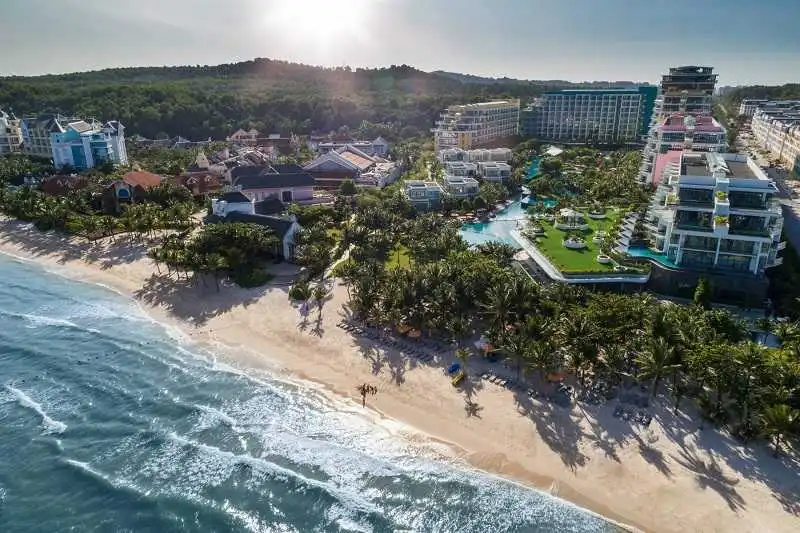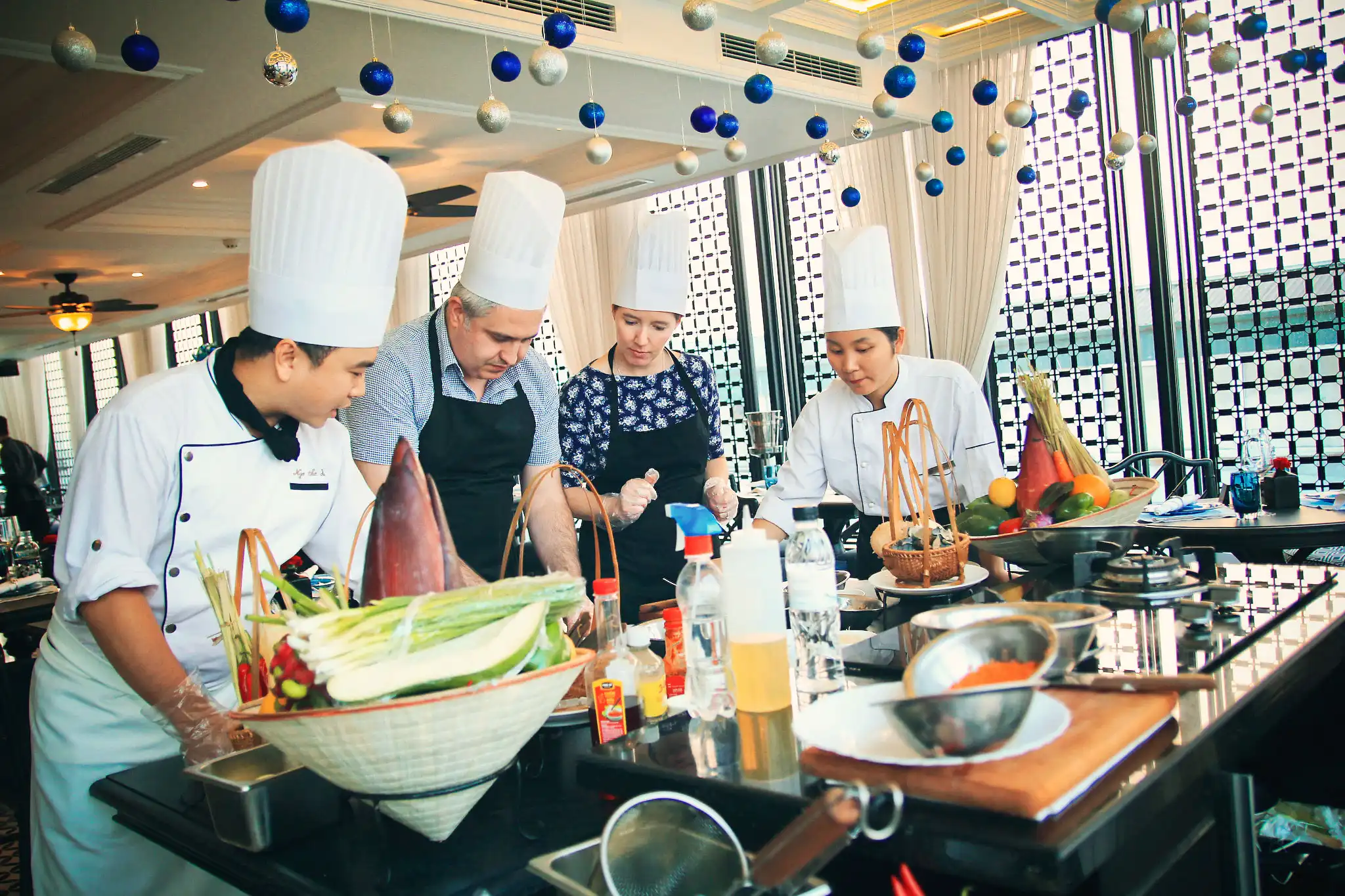
Did you know that besides its pristine beaches, Phu Quoc is home to a vast primary forest, recognized by UNESCO as a World Biosphere Reserve? That is Phu Quoc National Park—one of the island’s most fascinating natural destinations, home to hundreds of rare plant and animal species and a rich marine ecosystem. Explore exciting facts and essential tips for visiting Phu Quoc National Park in the article below!
Overview of Phu Quoc National Park

Phu Quoc National Park was originally established as a nature reserve before being officially upgraded in 2001. Spanning over 31,422 hectares, it has since become one of Vietnam’s most significant primary forests, playing a crucial role in biodiversity conservation and environmental protection.
With its diverse ecosystem, breathtaking landscapes, and high conservation value, the park not only plays a crucial role in preserving the ecological environment but also serves as an ideal destination for eco-tourism enthusiasts. Discover more about the location, size, and unique features of Phu Quoc National Park in the following sections!
Location
Phu Quoc National Park is located in Phu Quoc City, Kien Giang Province, spanning from 10°12′ to 10°27′ north latitude and 103°50′ to 104°04′ east longitude. The park covers the northern and northeastern regions of the island, including the communes and wards of Ganh Dau Phu Quoc, Bai Thom, Cua Can, Cua Duong, Ham Ninh, Duong To, and part of Duong Dong. From Duong Dong Town Center, the park is approximately 13–21 km away, which takes around 35–40 minutes to reach by motorbike or car.

The park also borders 60 km of coastline along the southwestern part of the island, featuring vibrant coral reefs and a unique marine ecosystem, creating a harmonious blend of forest and sea. If you’re planning a visit, be sure to check the Phu Quoc travel map to easily navigate the routes and explore the island’s most exciting attractions.
Acreage and Conservation Aspect

With a total area of 31,422 hectares (314.22 km²), Phu Quoc National Park covers 54% of the island’s total area and is divided into three functional zones:
- Strictly Protected Zone: 8,603 hectares (27.4%) – dedicated to preserving intact primary forests.
- Ecological Restoration Zone: 22,603 hectares (71.9%) – focused on reforesting degraded areas.
- Administrative and Service Zone: 33 hectares (0.7%) – designated for research and tourism activities.
In 2006, UNESCO recognized the park as part of the World Biosphere Reserve, highlighting its role in biodiversity conservation and sustainable tourism development. Notably, 97% of the park’s area consists of forests, including:
- 57.62% low-density evergreen broadleaf forest,
- 19.28% medium-density forest,
- 11.52% high-density rich forest.
Outstanding Features
Topography
The park’s terrain mainly consists of low mountains and hills, with its highest peak being Nui Chua (603m), part of the Ham Ninh mountain range. It features a dense river and stream network, with Rach Cua Can River—the largest river on the island—flowing westward into the sea. Other notable streams, such as Suoi Tranh Phu Quoc, Suoi Da Ngon, and Suoi Da Ban, contribute to a rich hydrological system, especially during the rainy season.

The area also includes mangrove forests and waterlogged Melaleuca forests, which are mainly found in low-lying coastal regions, playing a crucial role in preventing erosion and regulating the climate.
Biodiversity Values

Phu Quoc National Park serves as a vital conservation area for rare and scientifically valuable flora and fauna. According to research, the park is home to approximately 1,164 vascular plant species, belonging to 137 families and 531 genera, including precious timber trees such as Ven Ven (Hopea odorata), Melaleuca, Chestnut, and Sandalwood.

Notably, 12 endemic plant species are found only in Phu Quoc, including Cu Den Phu Quoc (Phu Quoc Lamp Tree), Diep Ha Chau Phu Quoc (Phyllanthus Phu Quoc), and Tam Thu Hung Phu Quoc (a rare tropical tree species). In terms of wildlife, the park harbors 43 mammal species, 84 bird species, and 47 reptile species, many of which are rare and endangered, such as the silvered langur, long-tailed macaque, and sea eagle. This rich biodiversity makes Phu Quoc National Park one of Vietnam’s and the world’s most significant conservation areas.
With its unique geographical location, vast area, and diverse landscapes and ecosystems, Phu Quoc National Park is not only the “green lung” of the island but also a must-visit destination for nature lovers seeking to explore the unique values of a tropical rainforest ecosystem.
Tourism Activities in Phu Quoc National Park
Phu Quoc National Park not only captivates visitors with its stunning natural landscapes but also offers unique and exciting experiences. Here are some must-try activities when exploring this pristine rainforest!
Enjoying the Wildlife

With its diverse ecosystem, Phu Quoc National Park is home to many rare animal species. Visitors may encounter approximately 30 mammal species, 200 bird species, and 50 reptile species within the park. Notable wildlife includes the silvered langur, long-tailed macaque, and black eagle.

Beyond its rich forest ecosystem, Phu Quoc National Park also boasts a vibrant marine ecosystem, featuring 100 species of hard coral, 20 species of soft coral, and over 60 species of seaweed. Notably, the park provides a habitat for rare marine creatures such as dugongs, noble volutes, giant clams, and hawksbill turtles, contributing to a colorful and ecologically significant marine environment.
Observing these wildlife species in their natural habitat promises an unforgettable experience for visitors.
Phu Quoc National Park Trekking

Trekking in Phu Quoc National Park offers visitors the chance to explore the pristine rainforest through a variety of scenic trails. Some of the most popular trekking routes include:
- Central National Park Trail (Rung Giong Trail): This 4 km trail takes visitors through six streams and slippery forest paths, providing a challenging yet rewarding trekking experience. Along the way, you can admire diverse vegetation and centuries-old giant trees. The best time for trekking this route is from October to April, when the weather is dry, and the streams are still full of water.
- Other Trekking Routes: Apart from the main trail, there are several alternative routes with varying lengths and difficulty levels, catering to different fitness levels and preferences. Proper preparation, including suitable clothing, sturdy footwear, and sufficient water, is essential to ensure a safe and enjoyable trekking experience.
Soaking in the Spring Water of the Forest

After an exhausting trekking adventure, there’s nothing better than cooling off in the refreshing waters of the streams within Phu Quoc National Park. Streams like Suoi Da Ngon, Suoi Da Ban, and Suoi Tranh boast breathtaking landscapes, where crystal-clear water flows over large and small rocks, creating a serene and relaxing atmosphere. These spots are perfect for a refreshing dip, allowing you to soak in nature, breathe in the fresh air, and rejuvenate your energy.
Where to Stay After Traveling to Phu Quoc National Park

When planning a visit to Phu Quoc National Park, choosing the right accommodation plays a crucial role in enhancing your travel experience. A great recommendation is Premier Residences Phu Quoc Emerald Bay, a 5-star resort located at Khem Beach—one of the top 100 most beautiful beaches in the world, as ranked by Flight Network in 2018.
⭐⭐⭐⭐⭐
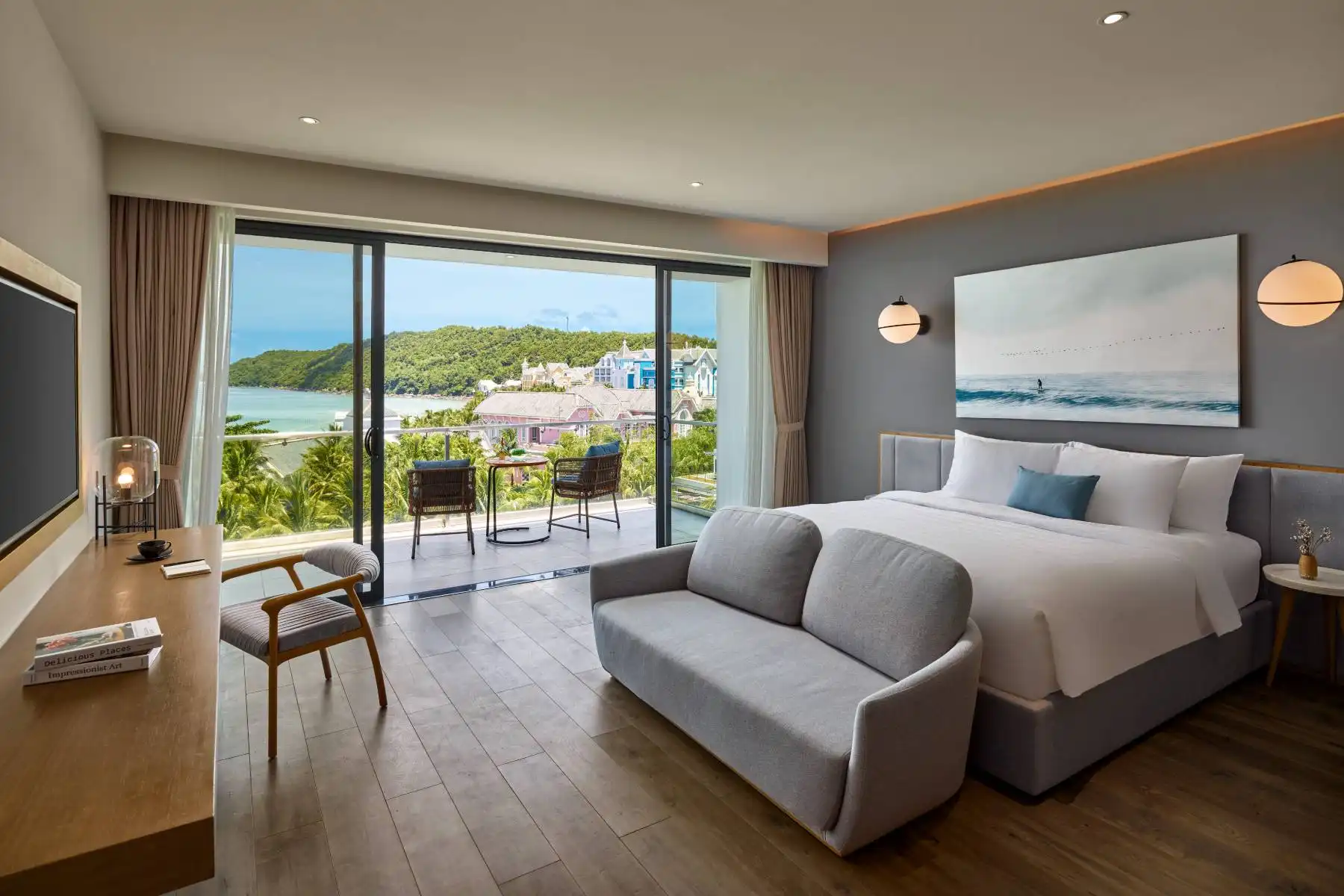

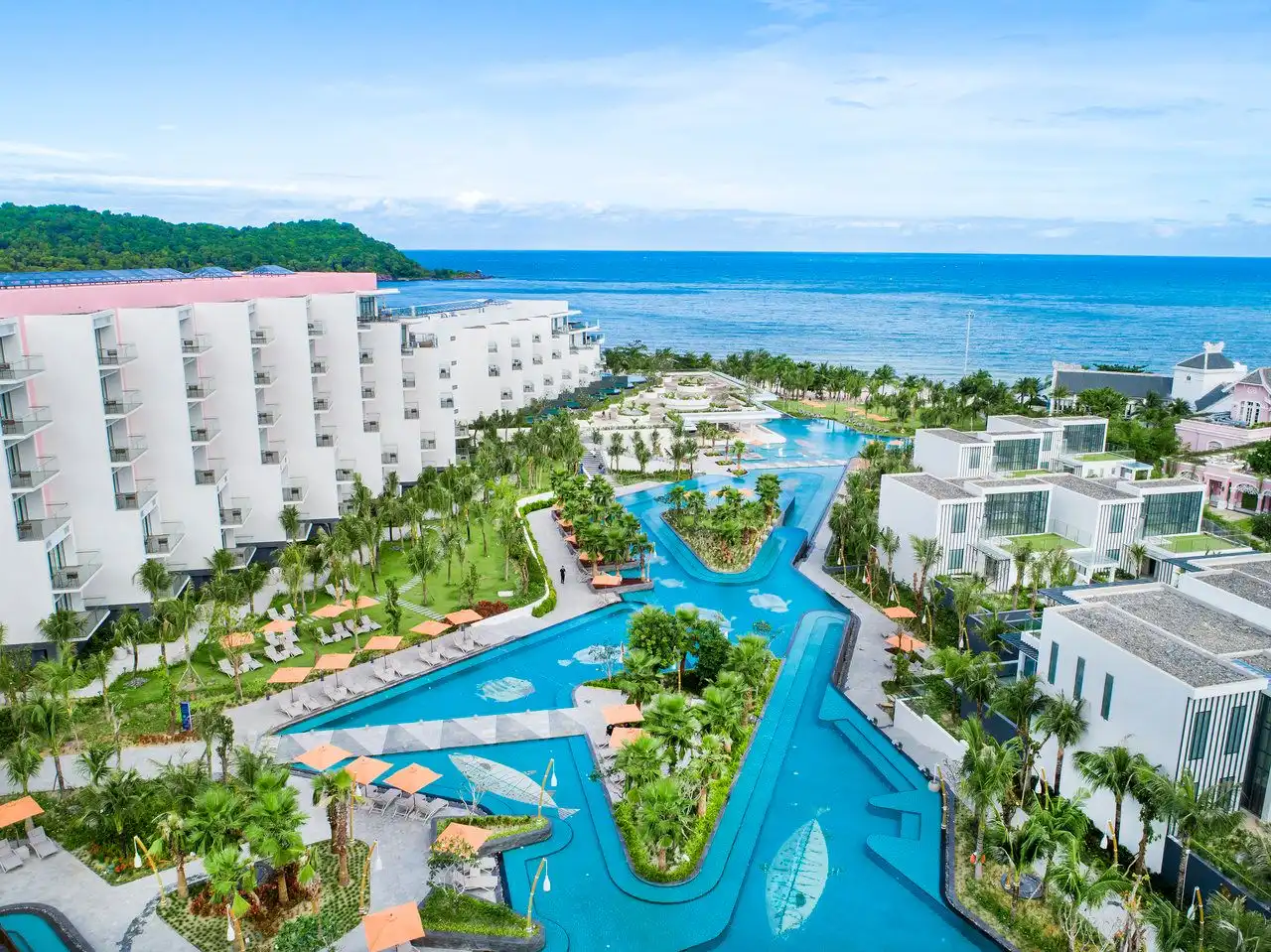

The perfect resort for families, couples and groups of friends
Thinking of a getaway in Phu Quoc? Check out our rooms and pricing to see what fits your vibe.
 The resort is also conveniently located near many famous attractions in Phu Quoc, such as Hon Thom Cable Car (12km), Kiss Bridge Phu Quoc, and Bai Sao Beach. With a 25-minute drive (~20km) from Phu Quoc International Airport and 40 minutes from Duong Dong Town, guests can easily explore all major attractions on the island.
The resort is also conveniently located near many famous attractions in Phu Quoc, such as Hon Thom Cable Car (12km), Kiss Bridge Phu Quoc, and Bai Sao Beach. With a 25-minute drive (~20km) from Phu Quoc International Airport and 40 minutes from Duong Dong Town, guests can easily explore all major attractions on the island.

Additionally, Premier Residences Phu Quoc Emerald Bay has been honored with multiple prestigious awards in the tourism and hospitality industry, reinforcing its top-tier reputation in Vietnam and Asia. Notably, the resort was awarded Best Hotel Service in Asia by the Haute Grandeur Global Awards 2024, recognizing its modern living spaces and world-class services, delivering a comfortable experience for every guest.

With a modern design and 752 rooms overlooking the turquoise sea, Premier Residences Phu Quoc Emerald Bay provides the perfect relaxation retreat for families, couples, and groups of friends. The spacious two-bedroom and three-bedroom apartments, ranging from 80m² to 170m², are fully equipped with modern amenities, ensuring maximum comfort for guests. This makes it an ideal choice for those seeking a well-equipped getaway amid the stunning natural beauty of Phu Quoc Island.

One of the resort’s key highlights is Emerald Spa, offering guests a rejuvenating experience after trekking adventures in Phu Quoc National Park. The spa features 10 private treatment rooms, including three VIP rooms equipped with steam and sauna facilities, catering to a wide range of wellness needs.
At Emerald Spa, treatments combine traditional Vietnamese techniques with natural ingredients such as fresh fruits, herbs, and tropical vegetables. Each therapy is designed to promote physical and mental balance, helping guests restore energy from within.
Phu Quoc National Park Travel Guide
To ensure a smooth and fulfilling adventure in Phu Quoc National Park, check out these useful travel tips to help you prepare for an unforgettable trip!
Best Time to Visit Phu Quoc National Park
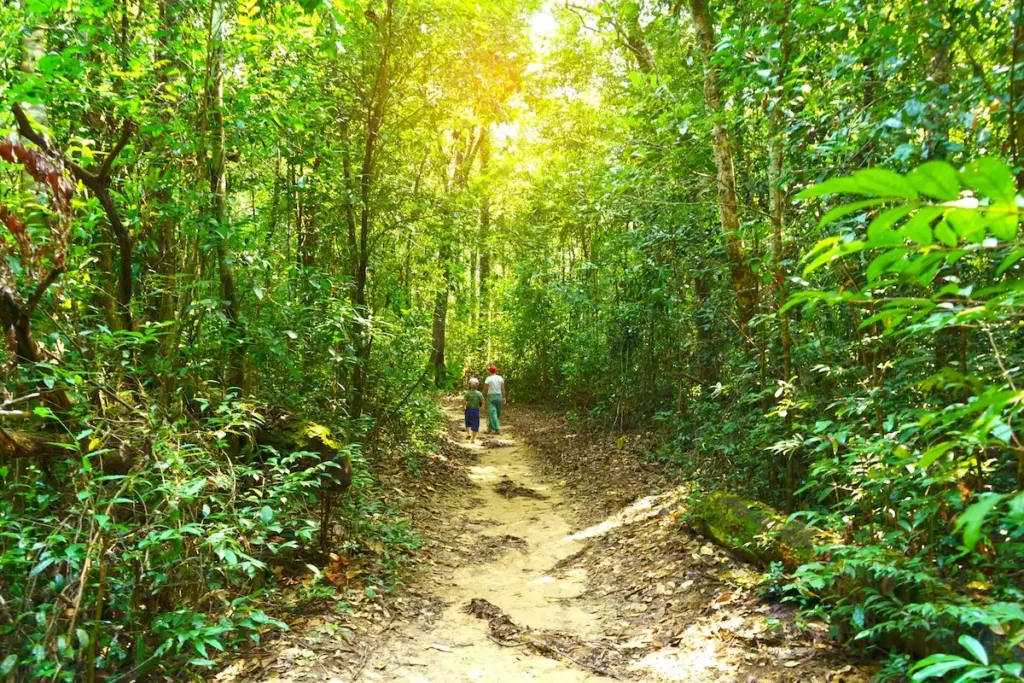
The ideal time to visit Phu Quoc National Park is from October to April, when the weather is dry with minimal rainfall, making it perfect for outdoor activities such as snorkeling in Phu Quoc and fishing trips. During this period, temperatures range from 25-28°C, creating ideal conditions for trekking and nature exploration.
How to Get There

From Duong Dong Town, you can rent a motorbike or car to reach Phu Quoc National Park. The journey covers approximately 13 km northeast via Nguyen Trung Truc Road, then turning right at the Duong Dong – Bai Thom intersection and continuing another 6 km to the park entrance. Note: The last 8 km leading into the primary forest is a dirt road, so it’s essential to choose a suitable vehicle and check road conditions before departure.
Food and Dining Tips

As Phu Quoc National Park is not a tourist resort, there are no restaurants or food stalls inside or nearby. Therefore, it is highly recommended to bring snacks and drinks before starting your journey. Essentials like bread, fruits, snacks, and bottled water will help you stay energized throughout your exploration.
See more: Top 20 Best Food in Phu Quoc for Food Lovers in 2025
What to Prepare for a Trip to Phu Quoc National Park?
Since this is an eco-tourism adventure exploring pristine nature, it’s essential to pack some necessary items to protect your health and ensure a comfortable journey:
- Wear Appropriate Clothing: Opt for comfortable, breathable clothing that absorbs sweat well. Wearing sports shoes is highly recommended for ease of movement on rugged trails.
- Bring Essential Items: Don’t forget to pack water, light snacks, insect repellent, and basic medical supplies to stay hydrated and prepared for any minor injuries.
- Lastly, ensure you are in good health and maintain a positive mindset before your trip to fully enjoy the natural beauty of Phu Quoc National Park!
Conclusion
We hope this article has provided you with a comprehensive overview of Phu Quoc National Park, helping you plan an exciting adventure into its pristine nature and rich biodiversity.
For a complete and unforgettable trip, consider staying at Premier Residences Phu Quoc Emerald Bay, the perfect retreat after a day of exploration. Book your stay today to enjoy a getaway and prepare for an unforgettable journey through Phu Quoc National Park!






